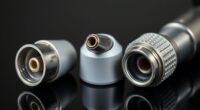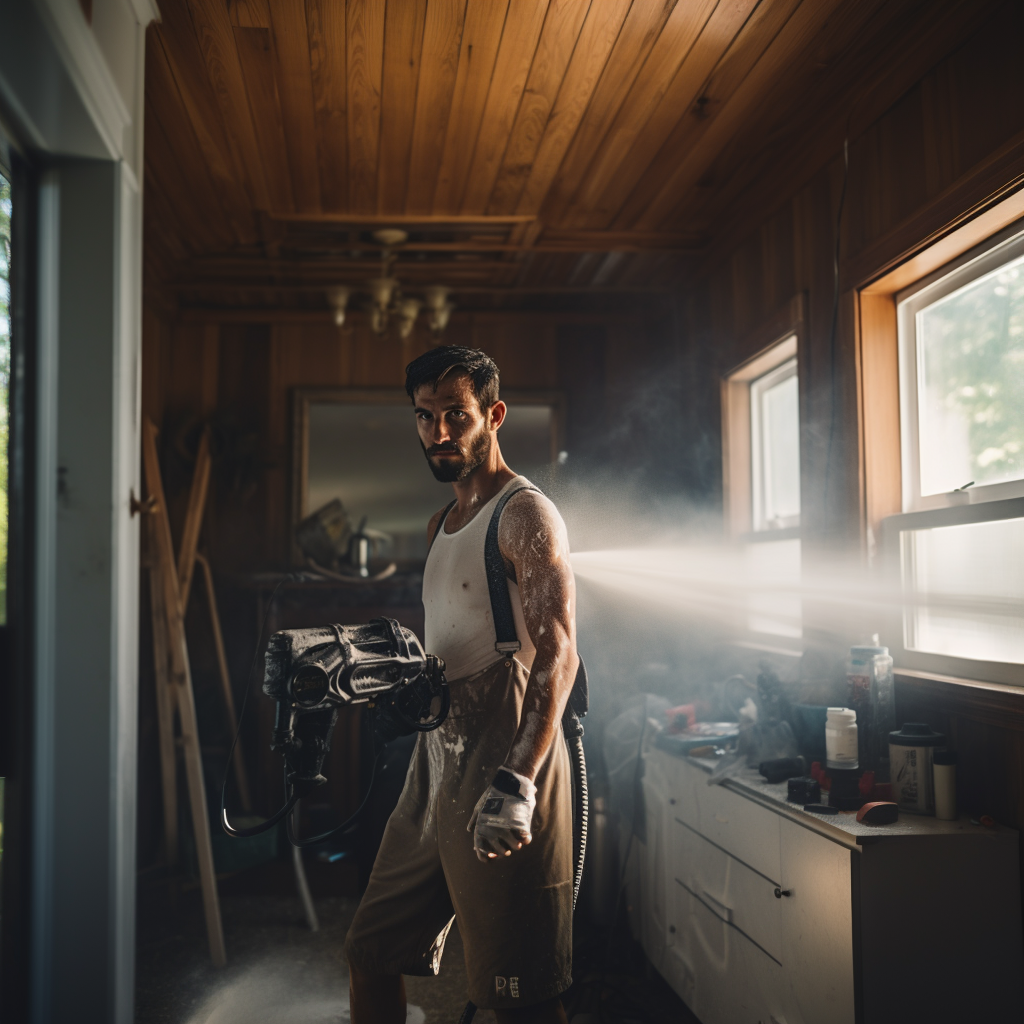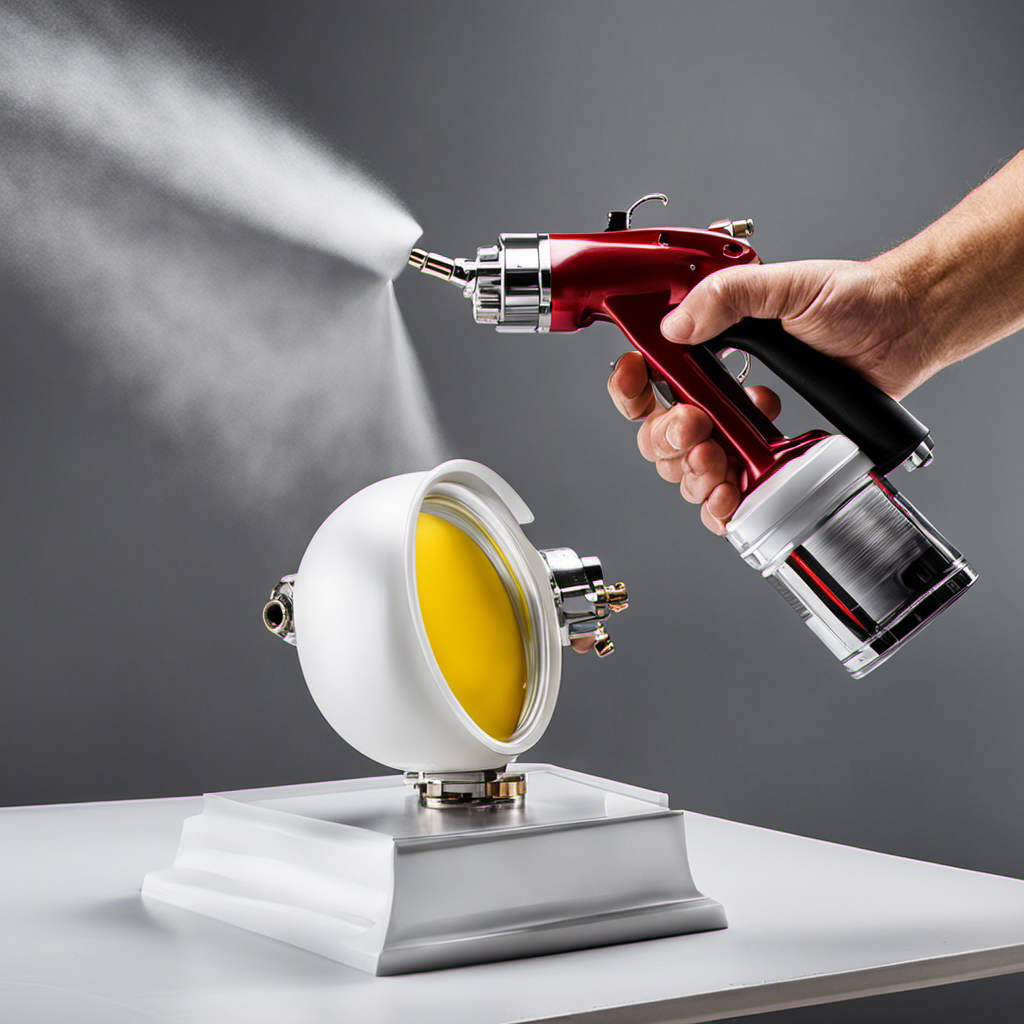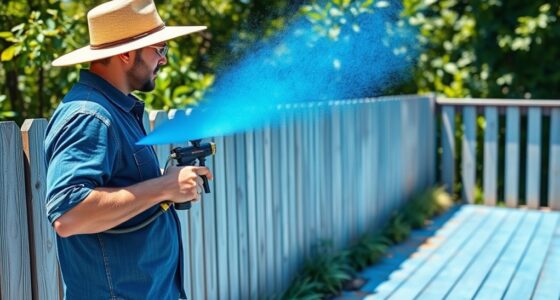When spraying fire doors with intumescent coatings, you guarantee an even, consistent application that boosts fire resistance and meets safety standards. Proper surface preparation, like cleaning and priming, is crucial for adhesion. Using the right equipment, such as airless sprayers, helps apply thin coats smoothly, reducing overspray and drips. Following safety procedures and manufacturer instructions guarantees effective protection. To discover how to optimize your application process and comply, keep exploring this essential safety topic.
Key Takeaways
- Proper surface preparation and priming are essential for effective adhesion of intumescent coatings on fire doors.
- Using spray equipment like airless or HVLP sprayers ensures uniform, thin layers for optimal fire resistance.
- Following manufacturer guidelines for application, drying, and re-coating guarantees coating performance during a fire.
- Safety procedures, including PPE and ventilation, are critical during spraying to prevent hazards and ensure compliance.
- Consistent, multiple thin coats applied with proper technique enhance the durability and fireproofing effectiveness of coatings.
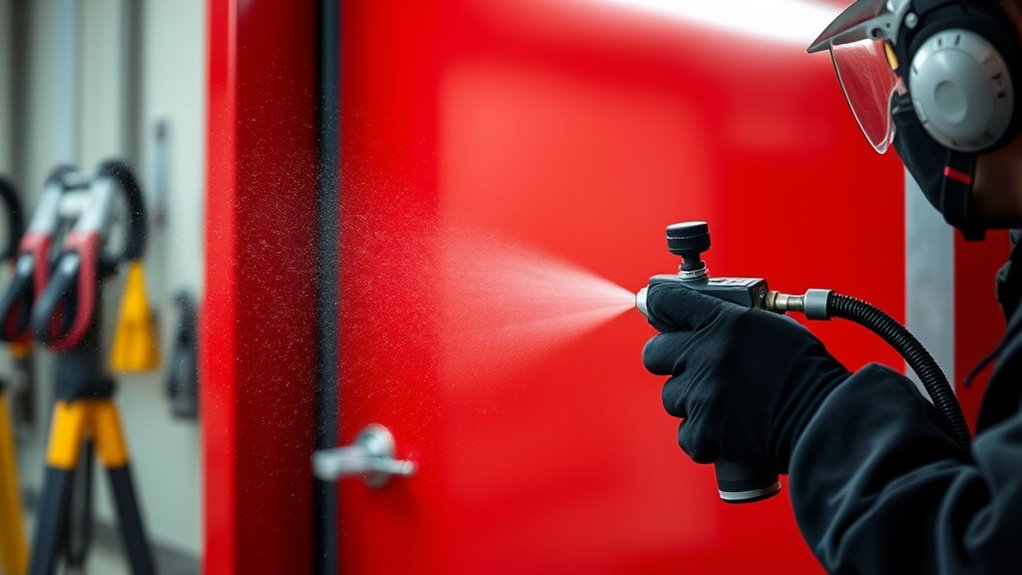
Spraying fire doors with intumescent coatings has become a popular method for guaranteeing effective fire protection. This approach not only enhances safety but also offers a streamlined application process that can be both efficient and reliable. As you consider this method, it’s essential to understand how fire safety regulations influence your choices. These regulations set the standards for fire resistance and ensure that buildings meet safety codes designed to protect lives and property. Complying with these rules means selecting the right coatings and applying them correctly, so your fire doors can withstand high temperatures and prevent the spread of fire for the required duration.
Compliance with fire safety regulations ensures your intumescent coatings effectively protect fire doors and save lives.
When it comes to coating application techniques, spraying stands out as one of the most effective options. Unlike brush or roller applications, spraying creates a uniform, thin layer that adheres seamlessly to the door’s surface. This method reduces the risk of uneven coverage, which can compromise the door’s fire resistance. To achieve the best results, you need to prepare the surface by cleaning and possibly priming it, ensuring the coating bonds properly. You’ll also want to select the right equipment—airless or HVLP sprayers are popular choices—that can deliver a consistent spray pattern and control the thickness of the coating.
Proper technique is essential. You should maintain a steady hand and consistent distance from the surface, typically around 12 to 18 inches, to prevent runs or drips. Overlapping each pass by about 50% helps ensure even coverage. Keep in mind that multiple thin coats are preferable to one thick layer, as this improves flexibility and adhesion while reducing the risk of cracking or peeling over time. Following manufacturer instructions on drying times and re-coating intervals is equally important to guarantee the integrity of the coating. Additionally, understanding industry trends can help you stay current with new materials and methods, ensuring your application remains compliant and effective.
Safety precautions are critical throughout the process. Wear appropriate personal protective equipment, including masks, goggles, and gloves, to shield yourself from fumes and overspray. Make sure the workspace is well-ventilated, and adhere to local fire safety regulations that might restrict the use of certain materials or require specific handling procedures. Proper disposal of excess coating and contaminated materials is also part of maintaining a safe environment.
In essence, spraying fire doors with intumescent coatings is a highly effective way to meet fire safety standards when done correctly. Focusing on proper application techniques and understanding the regulatory framework ensures your fire doors will perform as intended during an emergency. With attention to detail and adherence to safety and application protocols, you can confidently enhance your building’s fire protection and peace of mind.
Frequently Asked Questions
How Long Does a Sprayed Fire Door Maintain Its Protective Properties?
A sprayed fire door typically maintains its protective properties for around 10 to 15 years, depending on durability longevity and environmental conditions. You should perform regular maintenance checks every 1 to 2 years to verify the coating remains effective. If you notice any damage or wear, it’s crucial to reapply or touch up the coating promptly to preserve fire safety standards and extend the door’s protective lifespan.
Are There Environmental Considerations When Applying Intumescent Coatings via Spraying?
Yes, there are environmental considerations when applying intumescent coatings via spraying. You should evaluate the environmental impact of the application methods, as spraying can produce overspray and VOC emissions. Using environmentally friendly solvents and proper containment minimizes air and water pollution. Always follow local regulations and manufacturer guidelines to reduce ecological effects, ensuring the process is safer for the environment while maintaining effective fire protection.
Can Existing Fire Doors Be Retrofitted With Spray-Applied Intumescent Coatings?
You can retrofit existing fire doors with spray-applied intumescent coatings, but you should be aware of some challenges. Retrofit challenges include ensuring proper coating adhesion and compatibility with the door’s surface. Proper surface preparation and application techniques are essential to achieve a durable, effective protective layer. Consulting with specialists can help you navigate these challenges, ensuring your fire doors remain compliant and well-protected without extensive replacements.
What Are the Safety Protocols for Workers Applying Sprayed Fire Protection?
You should always wear proper personal protective equipment, like respirators, gloves, and goggles, to protect yourself from fumes and overspray. Make certain adequate ventilation to prevent inhaling harmful vapors and maintain a safe work environment. Follow safety protocols for handling chemicals, and use extraction systems when spraying. Regularly inspect your gear and ventilation setup to ensure they’re functioning correctly, keeping yourself safe throughout the application process.
How Does Spray Application Compare to Brush or Roller Coating in Durability?
Spray application generally offers better application consistency and more uniform coating thickness compared to brush or roller methods. This results in enhanced durability, as the coating is evenly distributed, reducing weak spots. You’ll find that sprayed fire protection creates a seamless barrier, which maintains its integrity longer under heat and wear. Overall, spray application provides superior durability, making it a reliable choice for long-lasting fire protection.
Conclusion
Remember, a job worth doing is worth doing right. When you spray fire doors and intumescent coatings properly, you guarantee safety and compliance. Using the right techniques and materials can make all the difference in protecting lives and property. Don’t cut corners—precision and care matter. As the saying goes, “Prevention is better than cure.” Invest in quality application now, and you’ll thank yourself later when every fire safety measure stands the test of time.
Franz came aboard the Paint Sprayer Zone team with a background in both journalism and home renovation. His articulate writing style, combined with a passion for DIY projects, makes him an invaluable asset. Franz has a knack for breaking down technical jargon into easy-to-understand content, ensuring that even the most novice of readers can grasp the complexities of paint sprayers.

